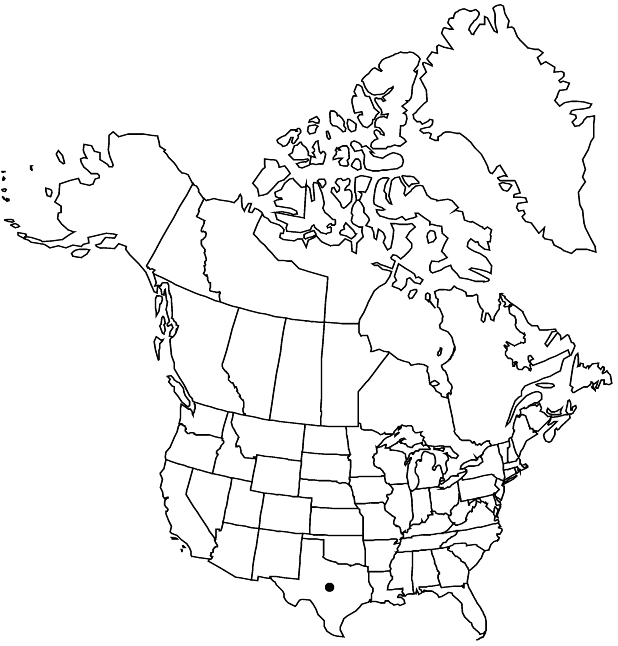Difference between revisions of "Styrax platanifolius subsp. texanus"
Ann. Missouri Bot. Gard. 84: 744. 1998 ,.
FNA>Volume Importer |
FNA>Volume Importer |
||
| Line 30: | Line 30: | ||
|distribution=Tex. | |distribution=Tex. | ||
|discussion=<p>Of conservation concern.</p><!-- | |discussion=<p>Of conservation concern.</p><!-- | ||
| − | --><p>Subspecies texanus has the narrowest distribution of the five subspecies of Styrax platanifolius, with documented localities in Edwards, Real, and Val Verde counties, and one population reported in Del Rio County. It is probably also the rarest of the subspecies, with fewer than 20 populations known. Only four of those populations consist of more than 25 individuals (J. M. Poole, pers. comm.). Although seed production and the germination rate of subsp. texanus are relatively high, grazing by both native and exotic herbivores has prevented regeneration within populations (P. A. Cox bis 1987; Poole, pers. comm.).</p><!-- | + | --><p>Subspecies texanus has the narrowest distribution of the five subspecies of <i>Styrax platanifolius</i>, with documented localities in Edwards, Real, and Val Verde counties, and one population reported in Del Rio County. It is probably also the rarest of the subspecies, with fewer than 20 populations known. Only four of those populations consist of more than 25 individuals (J. M. Poole, pers. comm.). Although seed production and the germination rate of <i></i>subsp.<i> texanus</i> are relatively high, grazing by both native and exotic herbivores has prevented regeneration within populations (P. A. Cox bis 1987; Poole, pers. comm.).</p><!-- |
| − | --><p>Young plants of subsp. texanus often have sparsely pubescent leaves abaxially, the tomentum developing with age.</p><!-- | + | --><p>Young plants of <i></i>subsp.<i> texanus</i> often have sparsely pubescent leaves abaxially, the tomentum developing with age.</p><!-- |
| − | --><p>Subspecies texanus is in the Center for Plant Conservation’s National Collection of Endangered Plants as Styrax texanus.</p> | + | --><p>Subspecies texanus is in the Center for Plant Conservation’s National Collection of Endangered Plants as <i>Styrax</i> texanus.</p> |
|tables= | |tables= | ||
|references= | |references= | ||
| Line 56: | Line 56: | ||
|publication year= | |publication year= | ||
|special status= | |special status= | ||
| − | |source xml=https://jpend@bitbucket.org/aafc-mbb/fna-data-curation.git/src/ | + | |source xml=https://jpend@bitbucket.org/aafc-mbb/fna-data-curation.git/src/8f726806613d60c220dc4493de13607dd3150896/coarse_grained_fna_xml/V8/V8_677.xml |
|genus=Styrax | |genus=Styrax | ||
|species=Styrax platanifolius | |species=Styrax platanifolius | ||
Revision as of 19:08, 18 September 2019
Young twigs faintly glaucous, glabrous except for scattered, orange-brown or dark-brown, stalked, stellate hairs proximally. Leaf blades: margins often weakly undulate, usually entire, rarely 3-lobed or coarsely toothed, abaxial surface with white stellate-tomentose pubescence in addition to scattered, orange-brown or dark-brown, stalked, stellate hairs on some leaves, surface completely covered and obscured by pubescence, adaxial surface glabrous. Pedicels white stellate-tomentose. Flowers: calyx thinly and evenly white stellate-tomentose, margins and teeth densely glandular, at least some teeth to 1 mm; style pubescent from proximal end to 15–35% of total length.
Phenology: Flowering Apr–May; fruiting Jul–Sep.
Habitat: Limestone cliffs, ledges, or cobble, intermittent drainages
Elevation: 500-700 m
Discussion
Of conservation concern.
Subspecies texanus has the narrowest distribution of the five subspecies of Styrax platanifolius, with documented localities in Edwards, Real, and Val Verde counties, and one population reported in Del Rio County. It is probably also the rarest of the subspecies, with fewer than 20 populations known. Only four of those populations consist of more than 25 individuals (J. M. Poole, pers. comm.). Although seed production and the germination rate of subsp. texanus are relatively high, grazing by both native and exotic herbivores has prevented regeneration within populations (P. A. Cox bis 1987; Poole, pers. comm.).
Young plants of subsp. texanus often have sparsely pubescent leaves abaxially, the tomentum developing with age.
Subspecies texanus is in the Center for Plant Conservation’s National Collection of Endangered Plants as Styrax texanus.
Selected References
None.
